Title search results
Showing 1 - 20 of 5461 items
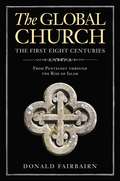
The Global Church---The First Eight Centuries: From Pentecost through the Rise of Islam
By Donald Fairbairn. 2021
Discover the Variety and Unity of the Early ChurchThe Christian church of the early centuries spread throughout much of Asia,…
Africa, and Europe, spoke many languages, was situated within diverse cultural settings, and had varied worship practices; yet it maintained a vital unity on core teachings at the heart of the Christian faith. In The Global Church--The First Eight Centuries: From Pentecost through the Rise of Islam, author Donald Fairbairn helps readers understand both the variety and unity of the church in this pivotal era by:Re-centering the story of the church in its early centuries, paying greater attention to Africa, Turkey, and Syria, where most of the church's intellectual energy was nurturedHighlighting Christian communities outside the Roman Empire, as far afield as Persia and India, alongside those within itIdentifying key events by their global, not merely Western, significance and taking into account early Christian interactions with other religions, particularly IslamThe Global Church--The First Eight Centuries is an ideal introduction to the patristic era that broadens the narrative often recounted and places it more firmly in its varied cultural contexts. Students of the early church, formal and informal alike, will appreciate the fresh approach and depth of insight this book provides.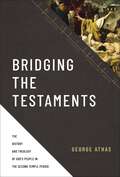
An accessible introduction to the historical and theological developments between the Old and New Testament.Bridging the end of the Old…
Testament period and the beginning of the New Testament period, this book surveys the history and theological developments of four significant eras in Israel's post-exilic history: the Persian Era (539-331 BC), the Hellenistic Era (332-167 BC), the Hasmonean Era (167-63 BC), and the Roman Era (63-4 BC). In doing so, it does away with the notion that there were four hundred years of prophetic silence before Jesus.Bridging the Testaments outlines the political and social developments of these four periods, with particular focus on their impact upon Judeans and Samarians. Using a wide range of biblical and extra-biblical sources, George Athas reconstructs what can be known about the history of Judah and Samaria in these eras, providing the framework for understanding the history of God's covenant people, and the theological developments that occurred at the end of the Old Testament period, leading into the New Testament. In doing so, Athas shows that the notion of a supposed period of four hundred years of prophetic silence is not supported by the biblical or historical evidence. Finally, an epilogue sketches the historical and theological situation prevailing at the death of Herod in 4 BC, providing important context for the New Testament writings.In this way, the book bridges the Old and New Testaments by providing a historical and theological understanding of the five centuries leading up to the birth of Jesus, tracking a biblical theology through them, and abolishing the notion of a four-century prophetic silence.
Astonishing and extinct professions: 89 jobs you will never do
By Markus Rottmann. 2023
The jobs we've lost are windows into the past. This book spans the centuries of the professional fartists and the…
walking toilets, of the brave riders of the Pony Express, the lazy ornamental hermits, and many more. For grades 3-6
The New Testament in Its World Workbook: An Introduction to the History, Literature, and Theology of the First Christians
By N. T. Wright, Michael F. Bird. 2019
This workbook accompanies The New Testament in Its World by N. T. Wright and Michael F. Bird. Following the textbook's…
structure, it offers assessment questions, exercises, and activities designed to support the students' learning experience. Reinforcing the teaching in the textbook, this workbook will not only help to enhance their understanding of the New Testament books as historical, literary, and social phenomena located in the world of early Christianity, but also guide them to think like a first-century believer while reading the text responsibly for today.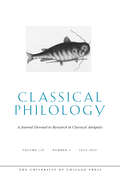
Classical Philology, volume 120 number 3 (July 2025)
By Classical Philology. 2025
This is volume 120 issue 3 of Classical Philology. Classical Philology (CP) has been an internationally respected journal for the…
study of the life, languages, and thought of the ancient Greek and Roman world since 1906. CP covers a broad range of topics, including studies that illuminate aspects of the languages, literatures, history, art, philosophy, social life, material culture, religion, and reception of ancient Greece and Rome.
Christendom: the triumph of a religion, AD 300-1300
By Peter Heather. 2023
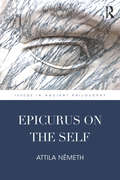
Epicurus on the Self (Issues in Ancient Philosophy)
By Attila Németh. 2017
Epicurus on the Self reconstructs a part of Epicurean ethics which only survives on the fragmentary papyrus rolls excavated from…
an ancient library in Herculaneum, On Nature XXV. The aim of this book is to contribute to a deeper understanding of Epicurus’ moral psychology, ethics and of its robust epistemological framework. The book also explores how the notion of the self emerges in Epicurus’ struggle to express the individual perspective of oneself in the process of one’s holistic self-reflection as an individual psychophysical being.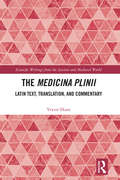
This book presents the first ever English translation of the Medicina Plinii, one of the most influential books of applied…
medicine and self-medication in Late Antiquity and the Middle Ages.The work, which predates AD 400, was created as a quick reference work for travellers, and became and remained highly influential, as witnessed by frequent references to it and by various later adaptations. Only the rise of scientific medicine and pharmacology led to its demise and confinement in a small corner of specialist studies. It presents more than 1,150 healing methods and recipes mainly adapted from the encyclopedic Natural History of Pliny the Elder, arranged from the patient’s head to foot in order that readers could quickly find treatments for their diseases. The Medicina Plinii is of dual interest to present-day scholarship: The book is a monument for the practical application of classical knowledge which has recently found lively interest in the history of science and medicine. At the same time the Medicina Plinii provides a fascinating insight into the realities of the world of Late Antiquity, and into the anxieties of the people living in the vast Roman empire.This book will be of particular interest to scholars and advanced students in the History of Science and Medicine, along with a wider audience interested in medicine, and in life in the Roman world.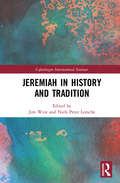
Jeremiah in History and Tradition (Copenhagen International Seminar)
By Jim West, Niels Peter Lemche. 2020
Jeremiah in History and Tradition examines aspects of the Book of Jeremiah from a variety of perspectives including historical, textual,…
redaction, and feminist criticism, as well as the history of its reception. The book looks afresh at the Book of Jeremiah through the lens of intertextuality and reception history in the broadest sense, exploring Jeremiah in its historical context as well as the later history and interpretation of the text, and also reconsidering aspects of the Book of Jeremiah’s traditions. This volume features essays from a unique assembly of scholars, both seasoned and new. It is divided into two parts: "Jeremiah in History", which explores a variety of readings of Jeremiah from the point of view of classical historical criticism; and "Jeremiah in Tradition", which discusses the portraits and use of both the book and the figure of Jeremiah in extra-biblical traditions. Offering challenging new theories, Jeremiah in History and Tradition is invaluable to scholars and students in the field of Biblical Studies. It is a useful resource for anyone working on the interpretation of the biblical text and the readings of the text of Jeremiah throughout history.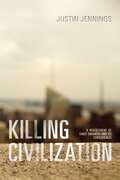
Killing Civilization: A Reassessment of Early Urbanism and Its Consequences
By Justin Jennings. 2016
The concept of civilization has long been the basis for theories about how societies evolve. This provocative book challenges that…
concept. The author argues that a &“civilization bias&” shapes academic explanations of urbanization, colonization, state formation, and cultural horizons. Earlier theorists have criticized the concept, but according to Jennings the critics remain beholden to it as a way of making sense of a dizzying landscape of cultural variation. Relying on the idea of civilization, he suggests, holds back understanding of the development of complex societies.Killing Civilization uses case studies from across the modern and ancient world to develop a new model of incipient urbanism and its consequences, using excavation and survey data from Çatalhöyük, Cahokia, Harappa, Jenne-jeno, Tiahuanaco, and Monte Albán to create a more accurate picture of the turbulent social, political, and economic conditions in and around the earliest cities. The book will influence not just anthropology but all of the social sciences.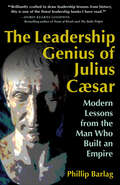
The Leadership Genius of Julius Caesar: Modern Lessons from the Man Who Built an Empire
By Phillip Barlag. 2016
The Leadership Genius of Julius CaesarModern Lessons from the Man Who Built an Empire"Brilliantly crafted to draw leadership lessons from…
history, this is one of the finest leadership books I have read."—Doris Kearns Goodwin, bestselling author of Team of Rivals and The Bully PulpitLeaders are always trying to get better, which is why there is an enormous and growing collection of literature offering the latest leadership paradigm or process. But sometimes the best way to move forward is to look back. Philip Barlag shows us that Julius Caesar is one of the most compelling leaders of the past to study—a man whose approach was surprisingly modern and extraordinarily effective. History is littered with leaders hopelessly out of touch with their people and ruthlessly pursuing their own ambitions or hedonistic whims. But Caesar, who rose from impoverished beginnings, proved by his words and deeds that he never saw himself as being above the average Roman citizen. And he had an amazing ability to generate loyalty, to turn enemies into allies and allies into devoted followers. Barlag uses dramatic and colorful incidents from Caesar's career—being held hostage by pirates, charging headlong alone into enemy lines, pardoning people he knew wanted him dead—to illustrate what Caesar can teach leaders today. Central to Barlag's argument is the distinction between force and power. Caesar avoided using brute force on his followers, understanding that fear never generates genuine loyalty. He exercised a power deeply rooted in his demonstrated personal integrity and his intuitive understanding of people's deepest needs and motivations. His supporters followed him because they wanted to, not because they were compelled to. Over 2,000 years after Caesar's death, this is still the kind of loyalty every leader wants to inspire. Barlag shows how anyone can learn to lead like Caesar.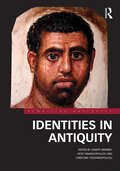
Identities in Antiquity (Rewriting Antiquity)
By Joseph Skinner, Christina Tsouparopoulou, Vicky Manolopoulou. 2025
Identities in Antiquity is a multi-disciplinary platform for the synthetic study of ancient identities, set in a more rounded and…
inclusive notion of antiquity.The volume showcases methodological and theoretical approaches to the study of ancient identities by scholars from different disciplinary backgrounds and career stages. In doing so, it promotes a more holistic approach to the study of ancient identities, facilitating comparisons between different periods and disciplines and generating new knowledge in the process. Chapters illustrating the intersecting, multifaceted, and mutable (or else highly immutable) nature of ancient identities address themes such as ethnicity, race, gender, mobility, religion, and elite and sub-elite identities – most notably that of the enslaved – in case studies spanning the ancient Mediterranean world and beyond, from the third millennium BCE until the early Middle Ages.The volume is suitable for students and scholars working on the Ancient Near East, the Graeco-Roman Worlds, Late Antiquity, and Byzantium, offering a valuable contribution to the study of past identities and the internal workings of ancient societies.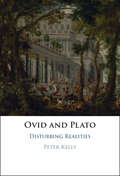
Ovid and Plato: Disturbing Realities
By Peter Kelly. 2025
The Roman poet Ovid, while sailing across the Black Sea to Tomis, considered his exile to have cosmic proportions; in…
the surging waves he sees his world seemingly veering back towards primordial chaos. Throughout his work Ovid seeks to depict the vast heterogeneity of the world, its creation and destruction, and the interconnection between humans and their unstable environment. This book explores how Ovid turns to philosophy, and especially the dialogues of Plato, to find meaning in a world that is fluid, uncertain, and dangerous. Rather than seeking recourse in an exact science of knowledge or a world of Forms beyond the here and now, Ovid sets himself apart from the philosophers. Instead, he highlights the limits of philosophy to capture the changing nature of reality and realigns the boundaries between poetry and science so as to create a more suitable medium for representing our entanglement with this complex world.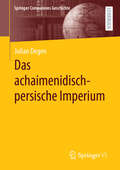
Das achaimenidisch-persische Imperium (Springer Companions Geschichte)
By Julian Degen. 2025
Diese Einführung bietet einen systematischen Überblick über die Geschichte des achaimenidisch-persischen Imperiums, das weithin auch als „Perserreich&“ bekannt ist. Dabei…
handelt es sich um die erste imperiale Formation der Antike, der es durch umfangreiche Eroberungen gelang, einen beeindruckenden Herrschaftsapparat zu errichten, der sich von Indien bis in nach Griechenland und von Äthiopien bis nach Zentralasien erstreckte. Dieses Imperium stellte die Bühne für zahlreiche schillernde Persönlichkeiten der Alten Welt dar, zu denen Kyros, Dareios, Xerxes, aber auch Alexander III. (der Große) zählen. Darüber hinaus setzte das Großreich Entwicklungen in Gang, die großen Einfluss auf die Welt Afro-Eurasiens ausübten und deren Dynamiken selbst in der Zeit nach seinem Niedergang bedeutsam waren. Insbesondere die Konflikte des Imperiums mit den Griechen fanden großen Nachhall in der antiken Geschichtsschreibung und ihre Präsentation stellt nach wie vor einen Orientierungspunkt des kollektiven Gedächtnisses moderner europäischer Gesellschaften dar. Aufgrund der enormen räumlichen Ausdehnung dieses Großreichs, das Herrschaft über eine Vielzahl an Kulturen ausübte, ist die Erforschung seiner Geschichte Gegenstand interdisziplinärer Forschungen. So sammelt diese Einführung Beiträge aus der Feder internationaler Spezialistinnen und Spezialisten aus unterschiedlichen Fachbereichen, die tiefgehende Einblicke in zahlreiche Aspekte der Geschichte des achaimenidisch-persischen Imperiums aus verschiedenen Perspektiven bieten.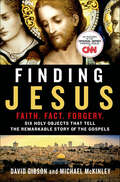
Finding Jesus: Six Holy Objects that Tell the Remarkable Story of the Gospels
By David Gibson, Michael McKinley. 1997
As featured in the 6-part CNN SERIES "Finding Jesus"FINDING JESUS explores six major artifacts, including the Shroud of Turin, the…
True Cross, and John the Baptist, that give us the most direct evidence about the life and world of Jesus. The book and attendant CNN series provide a dramatic way to retell "the greatest story ever told" while introducing a broad audience to the history, the latest controversies, and newest forensic science involved in sorting out facts from the fiction of would-be forgers and deceivers. The book and the show draw on experts from all over the world. Beyond the faithful, the book will also appeal to the skeptical and to curious readers of history and archaeology, while it takes viewers of the primetime TV series deeper into the story.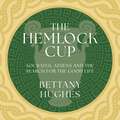
The Hemlock Cup
By Bettany Hughes. 2025
'Terrific and passionate writing about a philosopher whose heroism is unquestionable . . . and as lively and learned an…
introduction to classical Athens as you could want' - Daily TelegraphIn The Hemlock Cup, award-winning historian Bettany Hughes brings to vivid life one of the most influential thinkers the world has ever known: Socrates of Athens. A maverick philosopher who philosophised in squares and public arenas rather than the courts of kings, Socrates left his indelible mark on the entirety of Western civilisation - yet the life of the man himself is shrouded in mystery.What would life have been like in the Athens of Socrates's youth? How did the Socratic method come to dominate the way we think and learn? And what can Socrates teach us about how we should live? Drawing on fresh evidence and the latest archaeological discoveries, Bettany Hughes finally gives Socrates the biography he deserves - and shows just how relevant he remains to this day.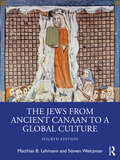
The Jews from Ancient Canaan to a Global Culture
By Steven Weitzman, Matthias Lehmann. 2025
This accessibly written volume examines the major periods of Jewish history around the world, from the Jews' distant origins in…
antiquity through the beginnings of the modern period and the emergence of secular culture.Although Jews are a small minority, they have settled in almost every part of the world, developing many different subcultures. They have had an outsized impact on global religion even as they have faced prejudice and persecution, and their history makes for a fascinating story of cultural change, adaptation, and survival that is continuing to unfold in the present. Now in a new edition as a split volume, this first volume of a comprehensive history of the Jews draws on up-to-date research to recount the story of the Jews from their beginnings in the ancient Near East through to the dawn of the modern period and the emergence of secular culture. Enhanced by images, limelight given to various historical mysteries, recommendations for how to learn more, as well as other features, the book moves chapter by chapter through the major periods of Jewish history, balancing introductions for those unfamiliar with that history with discussion of new approaches and recent discoveries that have reshaped understanding of the Jewish past.The book is useful not just for those interested in the Jews themselves but also for readers open to learning about global history from the vantage point of a people whose experiences attest both to the resilience of human culture and to the impact of hate and violence.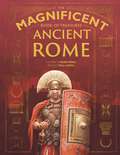
The Magnificent Book of Treasures: Ancient Rome (The Magnificent Book of)
By Stella Caldwell. 2022
Step back in time 2,000 years to visit the powerful Roman Empire. Every page reveals a fabulous treasure and its…
unique story—from gladiator battles with lions; chariot races for vast cheering crowds; and mock naval ship battles in flooded auditoriums, to mythical tales of magic and monsters; gods and goddesses for every occasion; and wondrous feasts in fantastical gardens. Learn about Ancient Rome&’s fast-food joints, the original multi-tool pocketknife, and how some escaped Pompeii&’s legendary volcanic eruption. DOZENS OF ARTIFACTS: Learn about 36 iconic objects, from a gladiator&’s sword to the original multi-tool pocketknife. BEAUTIFULLY ILLUSTRATED: Vibrant, detailed images of the art, objects, people, and icons of Ancient Rome. FASCINATING FACTS: Includes hundreds of amazing facts about Ancient Roman treasures in an easy-to-read Layout that will enthrall amateur historians of all ages. CLASSROOM TO COFFEE TABLE: This beautiful volume is equally at home on a school bookshelf to support student learning as in a living room to be enjoyed by the whole family. COLLECT THE SERIES: More fascinating compendiums for all ages include The Magnificent Book of Treasures: Ancient Rome, The Magnificent Book of Horses, The Magnificent Book of Extinct Animals, The Magnificent Book of Birds, and more!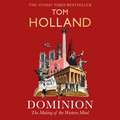
Dominion: The Making of the Western Mind (Dilly's Story)
By Tom Holland. 2019
'If great books encourage you to look at the world in an entirely new way, then Dominion is a very…
great book indeed . . . Written with terrific learning, enthusiasm and good humour, Holland's book is not just supremely provocative, but often very funny' Sunday Times History Book of the YearChristianity is the most enduring and influential legacy of the ancient world, and its emergence the single most transformative development in Western history. Even the increasing number in the West today who have abandoned the faith of their forebears, and dismiss all religion as pointless superstition, remain recognisably its heirs. Seen close-up, the division between a sceptic and a believer may seem unbridgeable. Widen the focus, though, and Christianity's enduring impact upon the West can be seen in the emergence of much that has traditionally been cast as its nemesis: in science, in secularism, and yes, even in atheism. That is why Dominion will place the story of how we came to be what we are, and how we think the way that we do, in the broadest historical context. Ranging in time from the Persian invasion of Greece in 480 BC to the on-going migration crisis in Europe today, and from Nebuchadnezzar to the Beatles, it will explore just what it was that made Christianity so revolutionary and disruptive; how completely it came to saturate the mind-set of Latin Christendom; and why, in a West that has become increasingly doubtful of religion's claims, so many of its instincts remain irredeemably Christian. The aim is twofold: to make the reader appreciate just how novel and uncanny were Christian teachings when they first appeared in the world; and to make ourselves, and all that we take for granted, appear similarly strange in consequence. We stand at the end-point of an extraordinary transformation in the understanding of what it is to be human: one that can only be fully appreciated by tracing the arc of its parabola over millennia.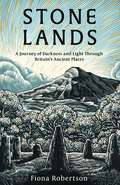
Stone Lands: A Journey of Darkness and Light Through Britain’s Ancient Places
By Fiona Robertson. 2025
'Superb' Telegraph'There's a real sense of peace and magic in this beautiful book' Daisy Buchanan'Utterly endearing' Dr James Canton'A fantastic…
book for weird walkers and megalith-obsessives alike' Weird WalkJourneying across Britain, from West Penwith and Avebury to the Lake District and Orkney, Stone Lands uncovers the magic and rich history of our incredible prehistoric standing stones. It conveys the delight that lies in tracking them down, as well as the solace these ancient places offer in times of darkness.A few months after discovering that her beloved husband, Stephen, had incurable cancer, Fiona Robertson began to write this book. A long-time megalith enthusiast, she found the ancient stones resonated with her more profoundly than ever as she faced the prospect of losing him. Set upright thousands of years ago, the megaliths are symbols of endurance and survival, standing in contrast to our ephemeral human lives. Infused with folklore, legend and mystery, they enchant the landscape and bring magic to our modern world. This enthralling memoir is woven delicately around great grief but is ultimately about embracing life, joy and ancient wonder - a luminous reminder of what it means to exist on this earth.Stone Lands is beautifully illustrated inside with stunning black and white line drawings by the illustrator and printmaker Philip Harris. Find out more about his work: www.philipharrisillustration.com'A reminder that the ancient stones can be sources of reassurance and solidity, even in our times of greatest upheaval and loss' Angeline Morrison